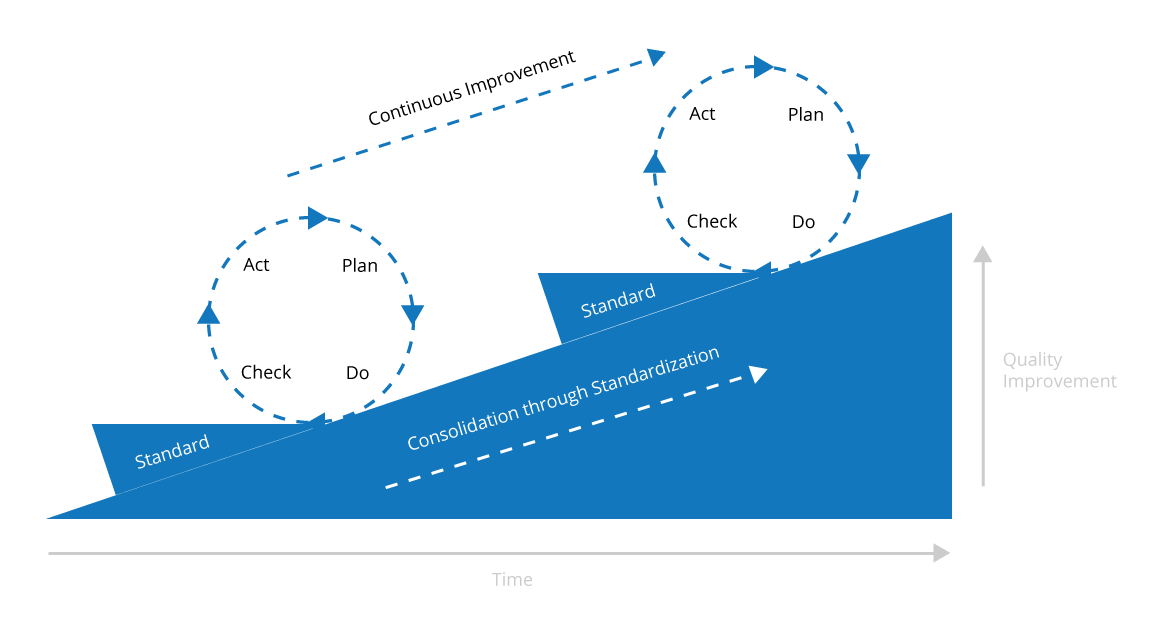
How to Use Kaizen to Improve Year-End Marketing Results
Following these four steps, you can evaluate last year’s ecommerce tactics and marketing results and adjust for the coming year.
Everything can be improved, including your marketing results.
That’s the principle behind Kaizen (change for the good), a management philosophy you can leverage to steadily improve your ecommerce marketing performance.
It’s also a principle that’s helpful to use when evaluating your marketing efforts for the year and planning for the year ahead.
At The Good, we love to see those quicker returns on investment that make our clients glad they chose us for their conversion optimization project.
Our real aim, though, is to join the celebration a year or more down the road when we compare previous and current year data. We typically aim for near-term high value gains in ROI, followed by steady continuous growth.
That’s accomplished by ongoing testing and tweaking. Conversion rate optimization isn’t a one-shot, set-it-and-forget-it process – it operates best on Kaizen principles.
Conversion rate optimization isn’t a one-shot, set-it-and-forget-it process. Share on XLet’s take a look at what those principles are and how they can help you make every day and every year the best one yet for your business.
The Fundamentals of Kaizen
No company today, no matter how large or successful, can afford to rest on past wins and stop innovating. Empowered by technology, business is moving at a faster rate than ever before. Yesterday’s sales don’t fill tomorrow’s quotas.
That’s exactly why the Kaizen approach is at the heart of the ongoing conversion rate optimization (CRO) methods we teach and support. In this article, we’re going to show you a simple four-step process you can use to adopt Kaizen in your ecommerce strategy to improve your marketing results.
First, though, here are a few special points about the origin and evolution of Kaizen:
- Kaizen is a Japanese term using “change” (kai) and “good” (zen) to describe a process of continued improvement; always changing for the better.
- Kaizen seeks total improvement in all areas of a company – every employee, every process, every day is a Kaizen opportunity.
- Kaizen stands in contrast to the popular mindset that you should never discourage someone or focus on mistakes. Kaizen deliberately seeks out trouble spots – but not so discipline can be dealt out, but so improvement can be made.
It’s that last point that tends to trip teams up. Nobody wants to take responsibility for sub-par work, yet Kaizen says all work is subpar, in that all processes and results can be improved. In the best companies, responsibility isn’t shirked; it is encouraged. The wise manager accepts total responsibility for every part of the assigned job.
The first step, then, is to get everyone onboard with the Kaizen philosophy. Make sure your team understands that finding things to improve doesn’t mean you’re focusing on mistakes. Rather, it indicates a culture of learning.
Find ways to reward incremental improvement. Celebrate tiny upticks as if they were gold – for little wins daily will add up to a significant change over time.
Four Steps to Kaizen in Ecommerce Marketing Results
Although Kaizen is most often identified as a management system birthed in Japan, the principles were introduced there by an American. In the aftermath of World War II, the United States sought to help rebuild the Japanese economy. It was then that statistician Edward W. Deming introduced the Plan, Do, Study, Act (PDSA) quality improvement cycle:
- Plan: Accept that change is a part of business. Look ahead and plan how to navigate that change.
- Do: Execute the plan, using small steps to test your hypothesis.
- Study: Observe the results and draw conclusions.
- Act: Apply what you know works and go back to the first step to continue the cycle.
Many companies and teams have used the basic principles of Kaizen to form their own management approach. For instance, the Toyota Production System, Six Sigma, and agile methodology are all rooted in Kaizen – as are the ongoing conversion optimization techniques we use at The Good.
How to Use Kaizen to Improve Year-End Marketing Results Share on XTesting is central to the ecommerce marketing strategy we find most effective. Do you see how the PDSA cycle perfectly describes the ‘always be testing’ concept? The big gains are always welcome, but our team gets excited over small advances too. When your results tell you you’re on the right track, then stay on that track. Make incremental changes and test at each juncture. Never assume you know the answer. Always test. That’s The Good way.

How to Apply Kaizen Principles to the Year-End Marketing Results Evaluation
The year-end assessment process we teach at The Good is not cookie-cutter Kaizen, but the elements are all in place.
Here are the basics of that system and the types of questions you’ll want to ask at each step:
Enjoying this article?
Subscribe to our newsletter, Good Question, to get insights like this sent straight to your inbox every week.
Start with Your Goals – PLAN
Examples of questions in the planning phase:
- Where did you want to be when you started the year?
- Which metrics did you choose to track your progress?
- What are the outcomes? Did you accomplish your goals?
Remember: you can’t manage what you can’t measure. Every objective must be tied to a means of tracking progress and evaluation results.
Inventory Your Tactics — DO
Examples of questions in the Do phase:
- What are the tactics your company deployed over the year?
- Explore your budget. Where did your money go?
- How much was invested in PPC?
- How much was devoted to content marketing?
- How much was focused on branding?
Identify the Wins and Losses — CHECK
Examples of questions in the Check phase:
- What tactics performed better than expected?
- What tactics performed worse than expected?
- What effect did each of those tactics have on your ROI?
- How do your results compare to known results from your industry?
Start Planning for Next Year — ACT
Examples of questions in the Act phase:
- Should you make any changes in the KPIs you’re using?
- What should your new performance goals be set at?
- Who will be responsible to track and manage each?
- What tactics exist today that you have yet to explore?
- Which tactics mark the most successful brands in your industry?
Prioritize your current high-ROI tactics, then establish your projections for next year.
By following those four steps, you can evaluate last year’s ecommerce tactics and adjust for the coming year. Note how the process breaks your overall performance down into component pieces for evaluation, then re-establishes them one-by-one.

The Primary Lesson Ecommerce Managers Should Learn from Kaizen
Financial planners love to point out how steady savings, compounded over time, can deliver incredible results. The same is true for conversion rate optimization coupled with Kaizen.
Take your ecommerce marketing ideas, tie them to your ecommerce KPIs list, decide which ecommerce metrics to track, and set your goals according to past performance and what you know to be true of top ecommerce metrics.
Evaluate your current situation and design a conversion growth program that will continually fuel and sustain conversions. Celebrate the big wins, but keep using a testing protocol to focus on the incremental advances that build and strengthen your future.
If you need help, ask us. Our business is to help you get optimum performance and marketing results from your strategy.
Recommended Reading:
- How to Make Better Digital Budget Decisions
- A Practical Guide to Website Benchmarking for Competitive Analysis
- When Toyota met e-commerce: Lean at Amazon

About the Author
Jon MacDonald
Jon MacDonald is founder and President of The Good, a digital experience optimization firm that has achieved results for some of the largest companies including Adobe, Nike, Xerox, Verizon, Intel and more. Jon regularly contributes to publications like Entrepreneur and Inc.